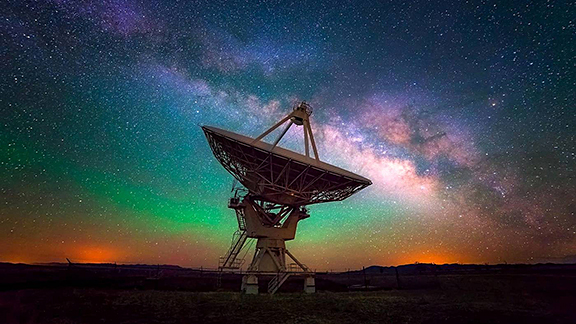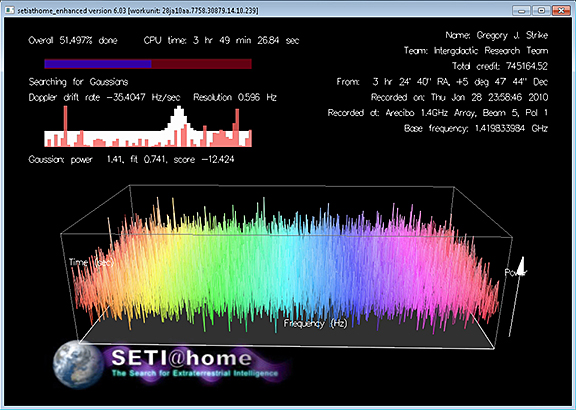SETI@Home
A recent television sci-fi experience, as well as the “UAP” discussions flying wildly about the Internet, got me thinking about the “olden days” of the computer, shared online experiences, and something called SETI (the Search for Extraterrestrial Intelligence).
As with many things scientific and cutting edge, we have to back up all the way to Nicola Tesla (was he a time traveler?) for its origins. “In 1896, Nikola Tesla suggested that an extreme version of his wireless electrical transmission system could be used to contact beings on Mars. In 1899, while conducting experiments at his Colorado Springs experimental station, he thought he had detected a signal from Mars since an odd repetitive static signal seemed to cut off when Mars set in the night sky.” (Wikipedia)
 Though this early observation has been “explained away” (sort of), Tesla was hardly the first to believe that there was likely intelligent life outside of Earth, though typically this was thought to be celestial or divine in nature, rather than other intelligent lifeforms that might one day, or had possibly already, contacted Earth.
Though this early observation has been “explained away” (sort of), Tesla was hardly the first to believe that there was likely intelligent life outside of Earth, though typically this was thought to be celestial or divine in nature, rather than other intelligent lifeforms that might one day, or had possibly already, contacted Earth.
Perhaps as one might expect, Mars is usually the planet discussed in the earlier days of hunting for extraterrestrial life. We can see Mars; it was found to have what appeared to be engineered structures on it though the “canals,” observed by Italian astronomer Giovanni Schiaparelli during the opposition of 1877, and confirmed by later observer were mistranslated from his word for them – “canali” (“channels”), into “canals” in English, seemed later to be natural ancient waterways or even optical illusions.
I do remember becoming intrigued by the idea of “Martians,” or ETs, in the book “Red Planet,” a 1949 Robert Heinlein novel about a boarding school on Mars, where students skate on the frozen canals, and many sci-fi novels and movies have supposed that life could, or perhaps did, exist on our nearby neighbor.
By the 1960s, interest in (and the rudimentary technology for) “listening” for signs of intelligent life spiked. “Cornell University astronomer Frank Drake performed the first modern SETI experiment, named “Project Ozma” after the Queen of Oz in L. Frank Baum’s fantasy books. Drake used a radio telescope 26 metres (85 ft) in diameter at Green Bank, West Virginia, to examine the stars Tau Ceti and Epsilon Eridani near the 1.420 gigahertz marker frequency, a region of the radio spectrum dubbed the “water hole” due to its proximity to the hydrogen and hydroxyl radical spectral lines. A 400 kilohertz band around the marker frequency was scanned using a single-channel receiver with a bandwidth of 100 hertz. He found nothing of interest.” (Wikipedia)
Still, the search went on. Joint government/technology corporation projects improved listening devices, and by the 1970s,”the Ohio State SETI program gained fame on August 15, 1977, when Jerry Ehman, a project volunteer, witnessed a startlingly strong signal received by the telescope. He quickly circled the indication on a printout and scribbled the exclamation “Wow!” in the margin. Dubbed the Wow! signal, it is considered by some to be the best candidate for a radio signal from an artificial, extraterrestrial source ever discovered, but it has not been detected again in several additional searches.” (Wikipedia)
Spectrum analysis and bigger “ears” enabled significantly better snooping, but one thing the investigation lacked was simply bandwidth.
Here is where my old computer call-in show, “Point ‘n’ Click,” came into play.
As one might expect from brilliant scientific minds, some people involved in the listening experiments thought it might make sense to involve the “average Joe and Jane” science and computer type. Thus began “SETI@home” (somewhat reminiscent of ET Phone Home). “SETI@home was conceived by David Gedye along with Craig Kasnoff and is a popular volunteer computing project that was launched by the Berkeley SETI Research Center at the University of California, Berkeley, in May 1999.
“Any individual can become involved with SETI research by downloading the Berkeley Open Infrastructure for Network Computing (BOINC) software program, attaching to the SETI@home project, and allowing the program to run as a background process that uses idle computer power. The SETI@home program itself runs signal analysis on a “work unit” of data recorded from the central 2.5 MHz wide band of the SERENDIP IV instrument. After computation on the work unit is complete, the results are then automatically reported back to SETI@home servers at University of California, Berkeley. By June 28, 2009, the SETI@home project had over 180,000 active participants volunteering a total of over 290,000 computers. These computers give SETI@home an average computational power of 617 teraFLOPS.[70] In 2004 radio source SHGb02+14a set off speculation in the media that a signal had been detected but researchers noted the frequency drifted rapidly and the detection on three SETI@home computers fell within random chance.” (Wikipedia)

Point ‘n’ Click joined the project, and it was a regular task to “listen,” and encouraging viewers to donate idle computer time to SETI@home’s mission. Unfortunately, while we routinely talked to highly intelligent and often “extra” types on the show (it was a call-in after all), we never made direct contact with an ET.
Though technically SETI@home is “in hibernation” at the moment, and tasks aren’t being assigned, individuals can get involved and listen, recording data and sending it in for analysis. You can learn more about the project at https://setiathome.berkeley.edu/ and you can catch up on the latest and greatest investigations – including some of the James Webb Space Telescope imagery at https://www.seti.org/.










